|
“Cobalt-Infused Lead-Glass-Filled Sapphires” are now commercially available in the world market in large quantities, in several qualities and styles, faceted or cut en cabochon and in sizes to 10 carats.
STARTING MATERIAL: Opaque, waxy, light-bluish-tinged whitish corundum with intense parting and/or surface-reaching fissures.
PROCESS: After soaking the stones in acid for several weeks, the additives (lead and cobalt compounds) are applied to the stones. The stones are heated in an electric furnace at 1200oC-1300oC in air for 4-10 hours. During the heating process, the cobalt is infused into the cracks and related voids "cannibalizing" the host corundum and producing blue clusters consisting usually of several corundum crystals forming one irregularly-shaped mass; subsequently, these clusters are fashioned into gemstones (faceted, cabochons).
|
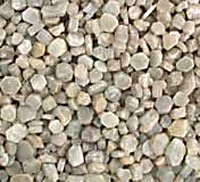 Starting material, African corundum, before the Pb+Co process. Starting material, African corundum, before the Pb+Co process. |
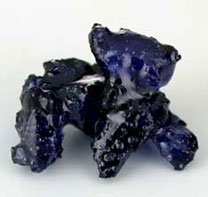 Cluster of corundum crystals after the Pb+Co process. |
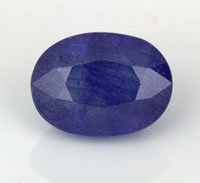 The final product: A faceted “Cobalt-infused lead-glass-filled sapphire" |
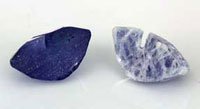 Pb+Co blue sapphire sliced: one portion was immersed overnight in a bitter Thai lemon juice (right); other portion (left) is the control sample. Pb+Co blue sapphire sliced: one portion was immersed overnight in a bitter Thai lemon juice (right); other portion (left) is the control sample.
|
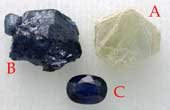
A = untreated
B = Pb+Co cluster
C= Pb+Co faceted
|

Cobalt-infused lad-glass-filled blue sapphire cut en-cabochon. |
|
Not all the rough corundum used in the process respond favorably to the Pb+Co treatment. The yield is about 25%-30% and to this time I have not been successful in determining which of these corundum are the “ideal” specimens for the Pb+Co process. I am working on the probability theory, sort of “hit-and-miss”. In most cases, the specimens must be re-treated several times (often with other additives) to achieve the resultant blue color residing mostly in the cracks.
Most of these cobalt-infused lead-glass-filled sapphires are transparent to semi-transparent. Depending on the type of starting material and Pb-Co ratio, several grades of the final product are produced: light, medium and dark blues, some of them reminiscent to fine quality Sri Lankan blue sapphires; other stones appear bluish with yellow spots, while others appear inky blue. The blue color resides mostly in the fissures and related voids in the host branching throughout the host corundum and appear like color zoning.
DETECTION: The treatment is easily detectable by almost anyone in the gem-jewelry trade.
STABILITY-DURABILITY: The Pb+Co sapphires are not stable and require special care as they may be damaged when soaked in detergent and acids or during jewelry repairs.
MORE: Additional experiments are currently conducted at Ted’s Gem Kitchen in heating similar type of corundum with nickel, manganese, etc. The results will be announced as available..
|
COMMENTS:
I call these stones “Cobalt-infused glass-filled Sapphires”, not “Cobalt-Doped Glass Filled Sapphires”, as reported in the Australian Gemmologist (First quarter 2013, Volume 25, number 1). These are the same stones reported erroneously in May 2012 as 'dyed'. “Blue dyed and clarity
modified sapphire with cobalt + lead-glass filler in fractures and
cavities”.
The reason I called these stones "infused" is because the cobalt is not diffused into the lattice of the host; it is infused mostly in the cracks and associated voids in the host. In my opinion, this is not the process that diffuses metals into a substrate (doped samples). I cannot imagine how cobalt in tetrahedral site can diffuse into the host corundum present in octahedral site. This is a problem that should be solved by serious electron microprobe analysis to prove the presence of diffusion gradient of cobalt in corundum.
Please be super careful how to use the above terminology to avoid confusion and uprising battles. In my opinion, the term "Cobalt-infused lead-glass-filled sapphire" defines the product properly and it is scientifically correct; the trade may give any name they wish.
I love to hear your opinion; drop me a note ted@themelis.com.
|
|
